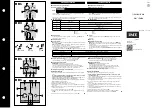
S4 Elements
745
Transformer Management Relay
Se
tpoints
http://www.GEindustrial.com/multilin
5–62
GE Multilin
FIGURE 5–22: Resistance Grounded Wye Wiring
An internal ground fault on an impedance grounded wye winding (see second figure
above) produces a fault current (
I
F
) dependent on the value of the ground
impedance and the position of the fault on the winding with respect to the neutral
point. The resultant primary current (
I
P
) will be negligible for faults on the lower
30% of the winding since the fault voltage will not be the system voltage but the
result of the transformation ratio between the primary windings and the percentage
of shorted turns on the secondary. Therefore, the resultant differential currents
could be below the slope threshold of the percent differential element and thus the
fault could go undetected. The graph below shows the relationship between the
primary (
I
P
) and fault (
I
F
) currents as a function of the distance of the fault point
from the neutral and FIGURE 5–24: RGF and Percent Differential Zones of Protection
outlines the zones of effective protection along the winding for an impedance
grounded wye.
FIGURE 5–23: Fault Currents vs. Points from Neutral
FIGURE 5–24: RGF and Percent Differential Zones of Protection
Wye Winding
FAULT
I
F
Delta Winding
I
P
Impedance grounded
wye winding
0
10
20
30
40
50
60
70
80
90
100
0
10
20
30
40
50
60
70
80
90
100
Ip(x)
Ifault(x)
%
Max
Ifault
Ifault
Ip
x = distance of fault from neutral
Rg
35%
RGF
ZONE
DIFFERENTIAL
ZONE
WINDING
Summary of Contents for Multilin 745
Page 2: ......
















































